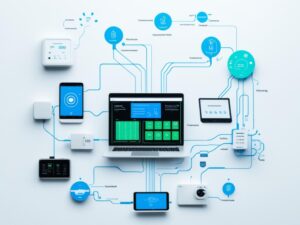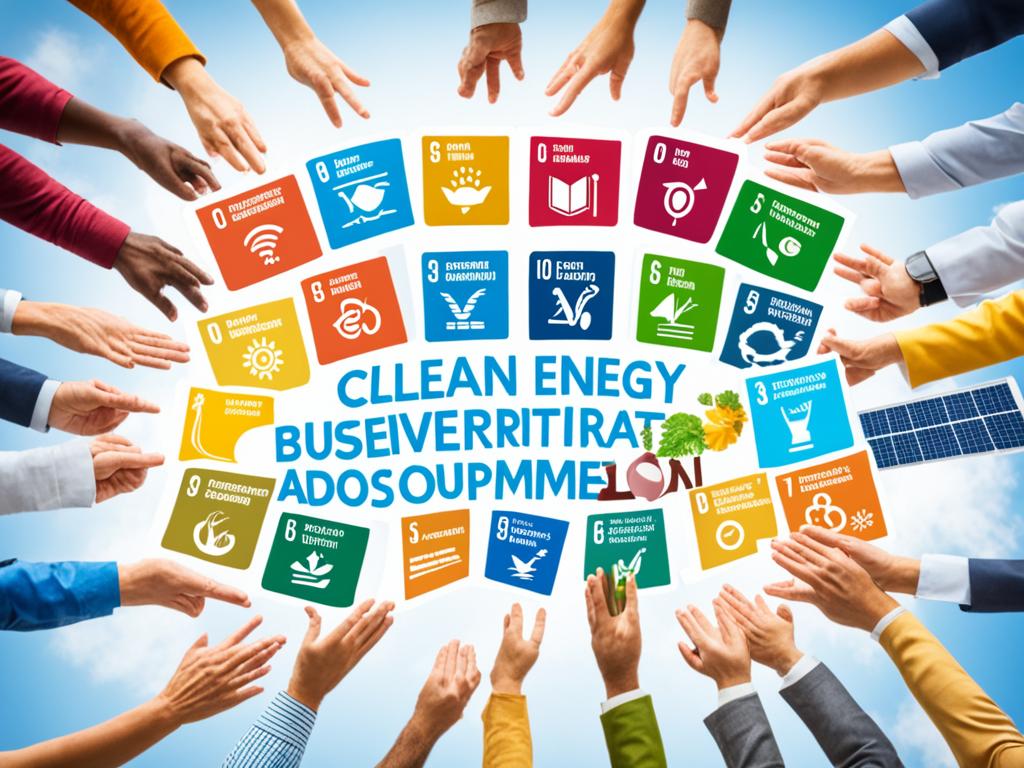
Education for Sustainable Development Goals
The world is facing big challenges like poverty, inequality, and climate change. The Sustainable Development Goals (SDGs) offer a plan to tackle these issues. Education is key to this plan, helping people, communities, and countries create a better future.
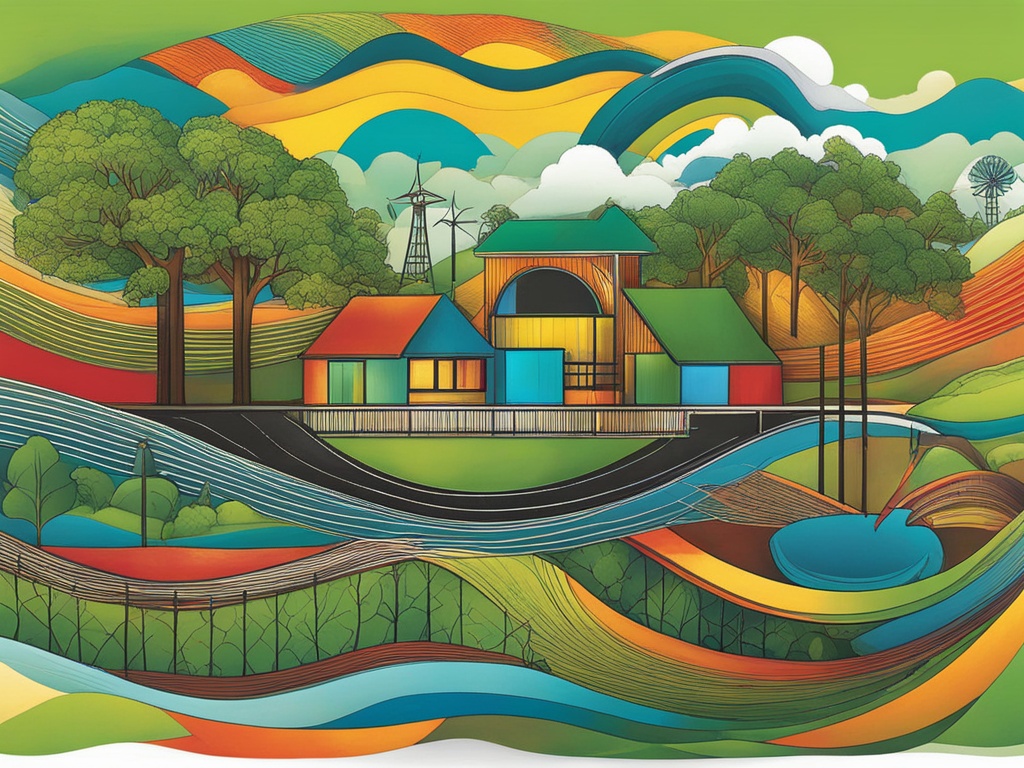
This article explores how education links to the Sustainable Development Goals. It shows how schools and learning can help us make progress in many areas. By teaching critical thinking and sustainable habits, education can help us meet the goals set by the SDGs.
Understanding the Sustainable Development Goals
The Sustainable Development Goals (SDGs) are 17 global goals set by the United Nations in 2015. They aim to tackle social, environmental, and economic issues. These include poverty, quality education, and climate action.
What are the Sustainable Development Goals?
The SDGs cover many topics, such as:
- No Poverty
- Zero Hunger
- Good Health and Well-being
- Quality Education
- Gender Equality
- Clean Water and Sanitation
- Affordable and Clean Energy
- Decent Work and Economic Growth
- Industry, Innovation, and Infrastructure
- Reduced Inequalities
- Sustainable Cities and Communities
- Responsible Consumption and Production
- Climate Action
- Life Below Water
- Life on Land
- Peace, Justice, and Strong Institutions
- Partnerships for the Goals
The Importance of Education in Achieving SDGs
Education is key to reaching the Sustainable Development Goals. It gives people knowledge and skills. It also helps build values and behaviors for a better world.
By investing in education, we empower people to help create a better future for everyone.
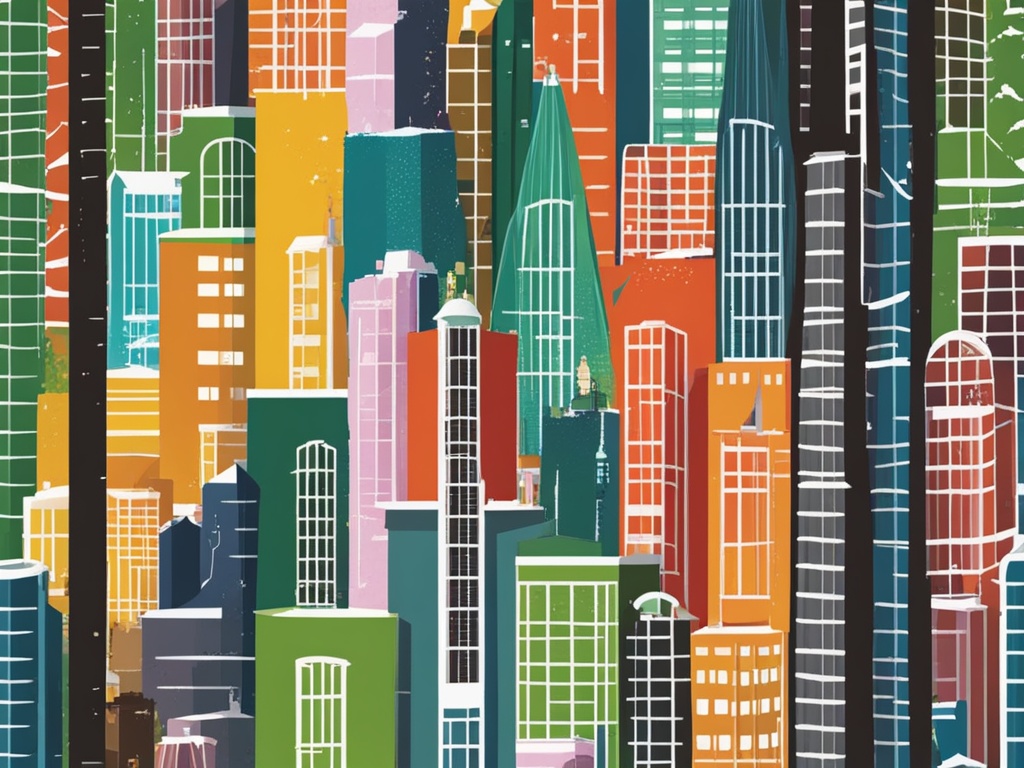
Promoting Quality Education
Quality education is key to sustainable development. It helps people and communities improve society. We aim to make education accessible, inclusive, and fair for everyone.
Gender equality is crucial in education. It means boys and girls have the same chance to learn. This helps create a fair world where everyone’s potential is used fully.
Inclusive education is also important. It means education for all, including those with disabilities or from marginalized groups. This way, every student can succeed.
Here are ways to improve education:
- Training teachers to be the best they can be
- Using new teaching methods for different learners
- Giving students the latest resources and technology
- Getting communities and parents involved in schools
- Overcoming issues like poverty and discrimination
By focusing on quality education, we help people and communities grow. This leads to a better, fairer world for everyone.
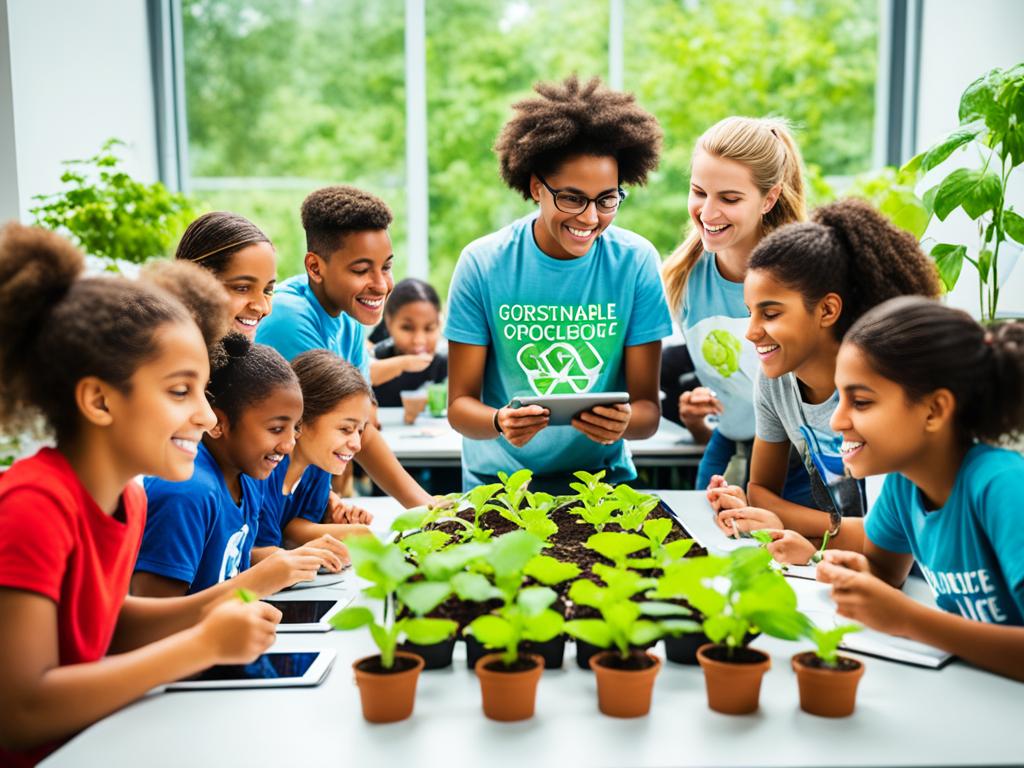
Sustainable Development Goals and Environmental Protection
The Sustainable Development Goals (SDGs) show how important protecting the environment is for a future that lasts. They focus on raising awareness about climate change and encouraging sustainable practices.
Raising Awareness about Climate Change
Climate change is a big issue covered by several SDGs, like Goal 13: Climate Action. By teaching people and leaders about climate change’s science and effects, we can push for climate action. This leads to better environmental protection.
Encouraging Sustainable Practices
The SDGs stress the need for sustainable practices, like using clean energy and managing resources wisely. By promoting these practices, we can cut down on pollution, save natural resources, and help make a greener future.

Putting environmental protection at the core of the SDGs shows we need a complete plan to tackle big global issues. By raising awareness and encouraging sustainable practices, we aim for a resilient and sustainable future for everyone.
Fostering Social Responsibility
Education is key in teaching people to care about others and their communities. It helps by teaching empathy, fairness, and making good choices. This way, schools prepare students to help make the world better.
One important part of this is making sure everyone is treated fairly. By using lessons that include everyone, we can fight against gender stereotypes. This helps women get the same chances as men. It also helps fight poverty by letting women reach their goals.
Education also helps people understand big issues like poverty and unfairness. It teaches critical thinking and problem-solving. This helps students come up with new ways to solve big problems. It makes them want to help their communities.

Education is a strong way to make the world fair and sustainable. By teaching people to be responsible, we can solve big social, economic, and environmental problems. This leads to a world that is just and wealthy for everyone.
Sustainable Development Goals and Economic Growth
The Sustainable Development Goals (SDGs) are more than just about protecting the environment and helping people. They also link closely to economic growth. By making sure everyone has equal economic chances, the SDGs help everyone in society grow economically.
Ensuring Inclusive and Equitable Economic Opportunities
Education is key to inclusive economic opportunities. It gives quality education and skills to those who need it most. This helps them join the economy and fight poverty by improving their lives.
The SDGs help in many ways to make the economy more open to everyone:
- Investing in vocational and technical education to develop a skilled workforce
- Ensuring access to financial services and entrepreneurship training for underserved populations
- Implementing policies that encourage the hiring and promotion of individuals from diverse backgrounds
- Promoting sustainable business practices that create jobs while minimizing environmental impact
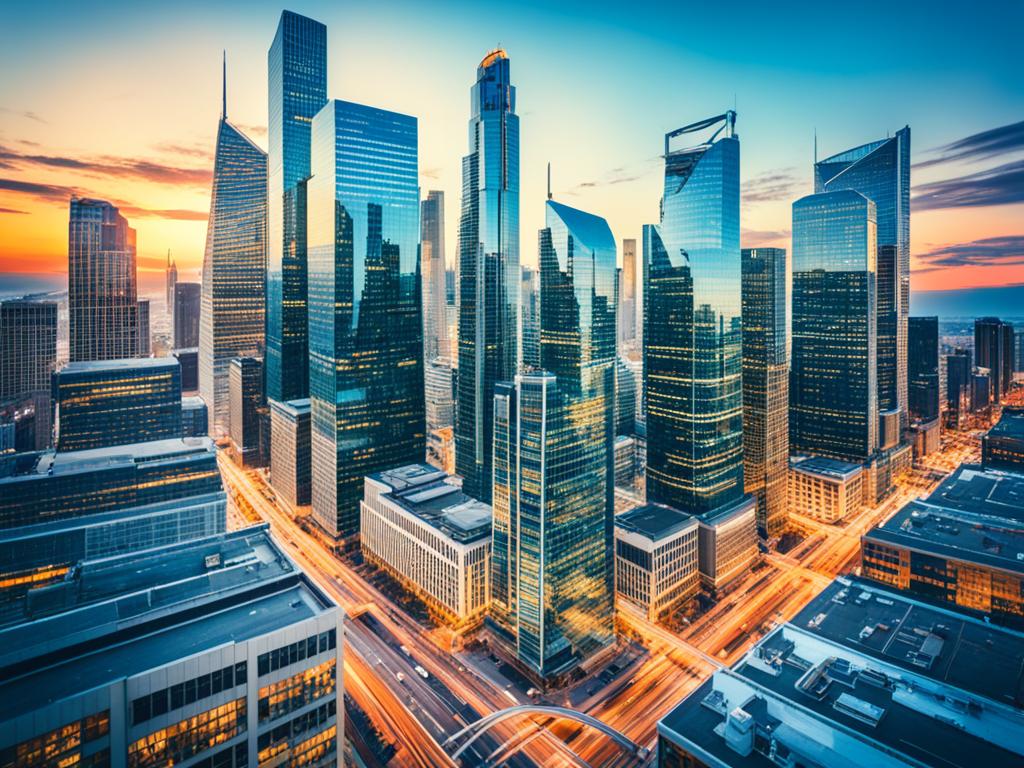
By focusing on these areas, the SDGs start a cycle of economic growth, inclusive economic opportunities, and poverty reduction. This leads to a future that’s better and fair for everyone.
Empowering Communities through Education
Education is key to empowering communities and fighting poverty. It gives people the knowledge and skills to better their lives and help in sustainable development. This way, we can tackle social and economic issues in communities.
Addressing Poverty Reduction
Quality education is essential for community empowerment and fighting poverty. Programs that focus on skills, vocational training, and financial literacy help people get better jobs. This leads to higher incomes, better living conditions, and more self-reliance in the community.
Community programs for marginalized groups like women and youth also boost community empowerment and poverty reduction. They provide specific support and chances for these groups to break the poverty cycle. This helps them contribute more to their local economies.
The quality education that empowers communities is vital for the Sustainable Development Goals. It sets the stage for lasting progress and better living conditions for everyone.
Sustainable Development Goals and Global Partnerships
Achieving the Sustainable Development Goals (SDGs) needs a global team effort. Nations, organizations, and communities must work together. This teamwork is key to using education to push for a better future.
Education helps people and communities take part in reaching the SDGs. By forming global partnerships, we make sure everyone gets quality education. This is vital for empowering communities and promoting sustainable development.
Strengthening Global Collaboration
Successful partnerships for sustainable development need a few important things:
- Sharing best practices and knowledge across borders
- Working together to solve common problems
- Gathering financial and technical support
- Building understanding and cooperation across cultures
When countries, groups, and communities aim for the same goal, their efforts get stronger. This leads to better and lasting solutions.
Empowering Local Communities
Global partnerships can also empower local communities. They make sure the good things from sustainable development reach the people. By investing in education and community projects, these partnerships help unlock the potential of local communities.
This way, we use the different views and strengths of communities worldwide. It creates a fair and inclusive way to achieve sustainable development.

Conclusion
This article has shown how education is key to empowering people, communities, and nations. It helps us reach the Sustainable Development Goals. By improving education, spreading awareness, and building global partnerships, we can make a better future for everyone.
The Sustainable Development Goals set by the United Nations tackle big issues like poverty, protecting the environment, and growing economies. Education is crucial in this fight. It gives people the knowledge and skills to make real change.
We’ve seen how good education can empower communities and spark innovation. It also helps us work together across borders. By supporting education that matches the Sustainable Development Goals, we help people and communities lead in sustainable progress. Let’s keep our focus on this important goal and work together for a brighter future for all.
FAQ
What are the Sustainable Development Goals?
The Sustainable Development Goals (SDGs) are 17 global goals set by the United Nations in 2015. They cover social, environmental, and economic issues. These include poverty reduction, quality education, gender equality, clean energy, and climate action.
Why is education important for achieving the Sustainable Development Goals?
Education is key to understanding and working towards the SDGs. It gives people the knowledge and skills to help in many areas. This includes fighting climate change, being socially responsible, and growing the economy.
How can education promote quality and inclusive learning opportunities?
Quality and inclusive education means everyone gets good learning chances, no matter their background. This means training teachers, making curricula inclusive, and giving all students equal access to resources. It focuses on helping marginalized communities too.
What is the connection between the Sustainable Development Goals and environmental protection?
The SDGs link closely to protecting the environment. Goals like climate action and clean energy focus on this. Education helps spread awareness about climate change and encourages sustainable habits to protect the environment.
How can education foster social responsibility and address social issues?
Education teaches people to be socially responsible. It tackles issues like gender inequality, poverty, and injustice. It gives people the skills to solve these problems effectively.
What is the relationship between the Sustainable Development Goals and economic growth?
The SDGs aim for economic growth that’s fair for everyone. Education helps marginalized communities join and benefit from economic progress. This leads to sustainable and fair economic growth.
How can education empower communities to achieve the Sustainable Development Goals?
Education gives communities the knowledge and skills to better their lives and support sustainable development. It helps with poverty reduction, healthcare access, and community projects that match the SDGs.
What is the role of global partnerships in achieving the Sustainable Development Goals?
Global partnerships are key to reaching the SDGs. Education helps by sharing knowledge and resources across borders. It enables people to work together on projects for a sustainable future.


